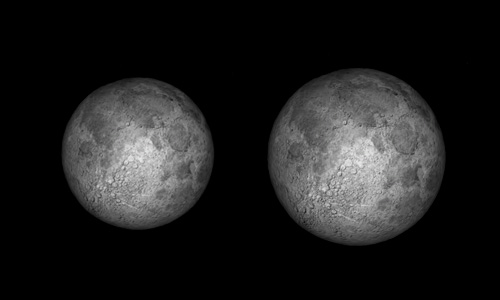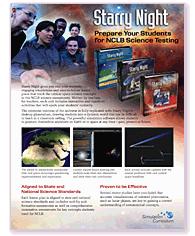|
If you have trouble viewing this newsletter, click here.
For education orders please call 1-877-290-8256.
Welcome again to our monthly newsletter with features on exciting celestial events, product reviews, tips & tricks, and a monthly sky calendar. We hope you enjoy it!

Follow Venus near the Sun
Venus is currently a prime observing target. It was at its greatest brilliancy on September 23, and is now moving swiftly towards inferior conjunction on October 28.
Because Venus’ orbit is closer to the sun that Earth’s, it passes between Earth and sun once every orbit. This is known as inferior conjunction to distinguish it from when Venus passes on the far side of the sun, known as superior conjunction.
Because Venus’ orbit is not in exactly the same plane as that of Earth, it usually passes above or below the sun at inferior conjunction. This year it will be passing below the sun. In addition, at this time of year the plane of the ecliptic is almost parallel to the horizon at sunset. As a result, Venus will be very low in the western sky at sunset, and hence very hard to observe.
The trick for observing Venus under these conditions is not to wait until sunset, but to observe Venus while the sun is still above the horizon.

WARNING: Observing close to the sun is very dangerous! This is something only very experienced observers should attempt, and they should take careful precautions to avoid viewing the sun directly.
To read the rest of this article, click here.
[Top of Page]

Did you see the Super Harvest Moon on September 22? Traditionally, the Full Moon nearest the fall equinox is called the Harvest Moon. This year, the equinox occurred only a few hours after moonrise in eastern North America making it a Super Harvest Moon.
Unfortunately, this caused some people to think that the Moon was bigger and brighter than ever before. As a matter of fact, the apparent size of the Moon was smaller than average. The images below allow you to compare the size of the Moon on September 22 with its size on January 1 of this year.

Moon's apparent size at September 22 (left) and January 1 (right).
This difference in apparent size of the Moon is caused by its orbital eccentricity.
To read the rest of this article, click here.
[Top of Page]

Autumn Equinox
Advance time Advance time using the "step time forward" button. When the Sun crosses the celestial equator, autumn begins in the northern hemisphere.
Pedro Braganca
Education & Content Director
Starry Night® Education
[Top of Page]


M15 is one of the most densely packed globular clusters in our galaxy, with a high number of variable stars and pulsars. Viewable with the naked eye from dark sites, binoculars and small scopes will bring out some detail of the collapsed, superdense core. M15 is also one of only a handful of globular clusters known to contain a planetary nebula.
NGC 7331, a Type 2 Seyfert galaxy about 43 million light-years away, shows a superb spiral structure.
51 Pegasi is an unexceptional 8th Mag star, but it's notable because it is orbited by the first true extrasolar planet to have been discovered.
Sean O'Dwyer
Starry Night® Times Editor
[Top of Page]
|
 |
 |
 |
 |
 |
 |
 |
The Layered Earth Videos

We’ve got a YouTube channel to showcase our new curriculum The Layered Earth. The Layered Earth is interactive geology and earth science curriculum for the middle school and high school classroom. A College version will be coming soon.
|
 |
 |
Pedro Braganca
Education & Content Director
Starry Night® Education
|
 |
 |
 |
 |
 |
 |
 |
Log Entries
Starry Night Pro, Pro Plus, High School and College allow you to add log notes to celestial objects.
To quickly see which objects have log entries associated with them, choose View->Show Log Markers from the main menu.
In the sky window, a red arrow will appear under a celestial object to indicate it has a log entry.
Pedro Braganca
Education & Content Director
Starry Night® Education
|
 |
 |
 |
 |
 |
 |
 |
Follow us at
• twitter.com/starrynightedu
|
 |
 |
 |
 |
 |
 |
 |
Moon Phases
 Thu., October 7 Thu., October 7
New Moon, 2:44 p.m.
The Moon is not visible on the date of New Moon because it is too close to the Sun, but can be seen low in the east as a narrow crescent the morning before, just before sunrise. It is still too low to be seen the evening after New Moon, but is visible in the southeast the next evening.
 Thu., October 14 Thu., October 14
First Quarter Moon, 5:27 p.m.
The First Quarter Moon rises around 3 p.m., and sets around midnight.
 Fri., October 22 Fri., October 22
Full Moon, 9:36 p.m.
The Full Moon of October is usually known as the HunterÃÂs Moon. Other names are Travel Moon, Dying Grass Moon, and Blood Moon. In Hindi it is known as Kojagiri or Sharad Purnima, Lakshmi Puja. Its Sinhala (Buddhist) name is Vap Poya. The Full Moon rises around sunset and sets around sunrise, the only night in the month when the Moon is in the sky all night long. The rest of the month, the Moon spends at least some time in the daytime sky.
 Sat., October 30 Sat., October 30
Last Quarter Moon, 8:46 a.m.
The Last or Third Quarter Moon rises around midnight and sets around 2 p.m. It is most easily seen just after sunrise in the southern sky.
Observing Highlights
To read the rest of this article, click here.
|
 |
 |
 |
 |
 |
 |
 |
Prepare Your Students for NCLB Science Testing

Starry Night® gives you and your students engaging stimulations and easy-to-follow lesson plans that teach the critical space science concepts in the NCLB science assessments.
Written by teachers, for teachers, each unit includes interactive and hands-on activities that will spark your students' curiosity.
Click here to download full brochure.
|
 |
 |
 |
 |
 |
 |
 |
NSTA Area Conference
October 28-30, 2010: Kansas City, MS
CAST (Science Teachers' Association of Texas) Conference
November 10-13, 2010: Houston, TX
Science Teachers' Association of Ontario (STAO) Conference
November 11-13, 2010: Toronto, ON
NSTA Area Conference
November 11-13, 2010: Baltimore, MD
NSTA Area Conference
December 2-4, 2010: Nashville, TN
Details...
|
 |
 |
 |
 |
 |
 |
 |
Educational Inquiries and Sales
Please contact Michael Goodman for all education inquiries. EDUCATION ORDERS 1-877-290-8256
|
 |
 |
 |
 |
 |
 |
 |
Send us your feedback
Do you have a question, comment, suggestion or article idea to pass along to Starry Night® Times?
Click here to get in touch with us.
|
 |
 |
 |
 |
 |
 |
 |
Starry Night® is the world's leading line of educational astronomy software and DVDs. Visit store.starrynight.com to see all the great products we offer for everyone from novice to experienced astronomers.
You have received this e-mail as a trial user of Starry Night® Digital Download or as a registrant at starrynight.com.
To unsubscribe click here.
To subscribe sign up here.
Starry Night® is a division of Simulation Curriculum Corp.
Simulation Curriculum Corp.
Starry Night® Education
11900 Wayzata Blvd.
Suite 126
Minnetonka, MN 55305
Tel:
1-866-688-4175
|
 |
 |
|








